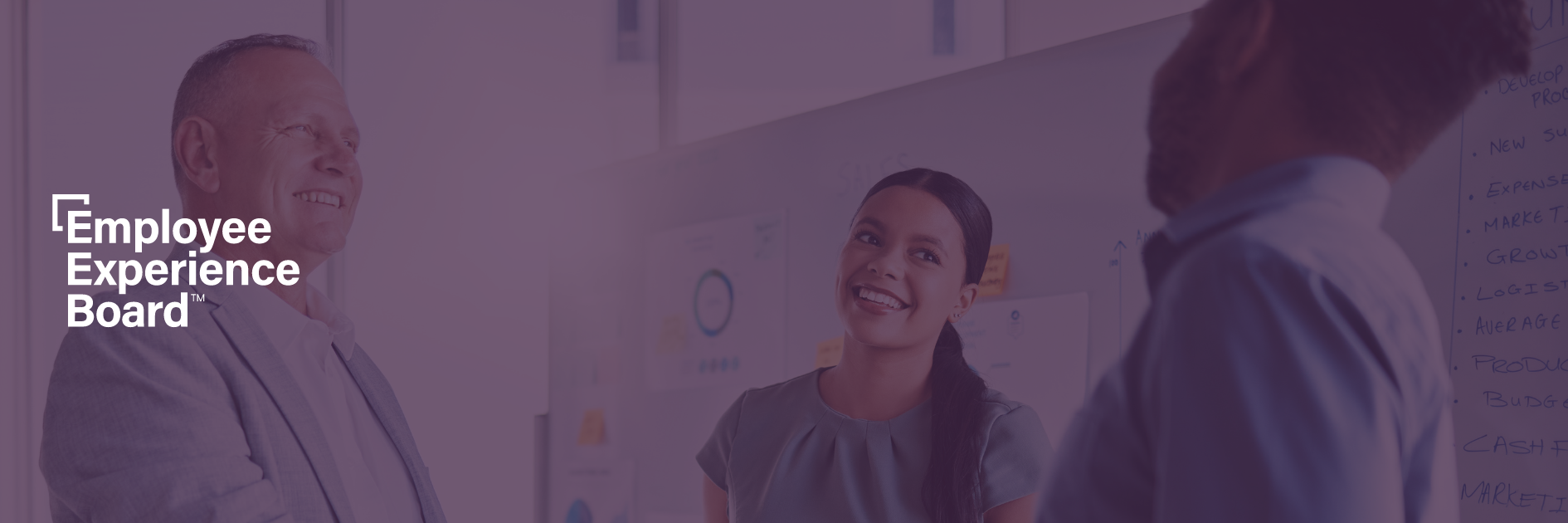Key takeaways:
- Gather continuous feedback: Implement feedback systems at key stages (e.g., 30, 60, 90 days) to identify onboarding pain points and make timely adjustments.
- Design a flexible onboarding process: Offer a mix of structured and flexible onboarding elements, including pre-recorded sessions and live meetings, to accommodate diverse work environments and schedules.
- Start personalization early: Begin relationship-building during pre-boarding with personalized communication, setting clear expectations, and creating a welcoming experience before the new hire’s first day.
Onboarding shapes the employee experience (EX), and a well-designed process boosts retention, engagement, and satisfaction. But how can EX leaders create onboarding that is truly personalized and meets today’s diverse workforce needs?
In a recent Employee Experience Board panel on enhancing onboarding, our members discussed strategies for personalizing onboarding to meet employee expectations.
We’ll highlight the actionable insights our members at Nutrien, Harbor Freight Tools, and Volvo Group shared for enhancing new hire experiences at your organization.
1. Gather Employee Feedback During the Onboarding Process
Gathering feedback from employees is a fundamental practice for refining the onboarding process. Ankur Makanji, Talent, Employee Experience, and Organizational Development Manager at Nutrien, shared how they use surveys to assess new hire experiences 45 days into their tenure.
“What we hear from people is that they want more basic stuff,” Ankur said. “On the first day, they want to make sure that they have the equipment to do their job, and their benefits are set up.”
He added that employees consistently ask for access to the best network drives and software.
“A lot of times we think just giving them a laptop is good enough. But we must give them full access to the areas where they need to do their job,” Ankur continued. “Some of those things are introductions to different teams and setting expectations for the role.”
He suggested implementing a structured feedback system at 30, 60, and 90 days to gather insights from new hires about their onboarding experience.
This feedback can help you identify common pain points, such as tech access or team introductions, and adjust your process accordingly.

A lot of times we think just giving them a laptop is good enough. But we must give them full access to the areas where they need to do their job.
Ankur Makanji, Nutrien
2. Create a Streamlined and Engaging Experience
Tammy Pinkston, Engagement Program Manager at Harbor Freight Tools, discussed the importance of streamlining the entire employee journey, from pre-hire to post-onboarding, to make the experience more engaging.
“Associates have told us they’re looking for an easy, streamlined, and visible experience” Tammy said. “They want to know what the journey will consist of and how to easily access information. Employees are also always saying they want that culture-driven experience and fun. They want that embedded into every single experience in the process.”
She added that it’s key to invest in creating a branded, user-friendly onboarding portal where employees can easily find all relevant documents, contact information, and cultural touchpoints.
Add personal touches, like welcome videos or department introductions, to create a sense of belonging from day one.

Employees are also always saying they want that culture-driven experience and fun. They want that embedded into every single experience in the process.
Tammy Pinkston, Harbor Freight Tools
3. Leverage a Multi-Stage Approach to Personalization
When it comes to personalization, Ankur said it’s critical to look at onboarding through multiple lenses, including business unit, team, and function.
“For example, the onboarding for someone who’s going to work in a potash mine is going to look much different than someone who’s selling fertilizer to farmers.” Ankur said.
Despite being decentralized, Nutrien follows a three-tiered onboarding approach: organizational, business unit, and team levels, with leaders playing a key role at the team level.
Ankur added that this allows for consistency across the company while providing leaders the flexibility to cater to the specific needs of different roles and functions.
4. Start the Personalization Process Early
Janet Russell Norton, Head of North American Talent Management Strategy, Leader Development, and Employee Relations at Volvo Group, shared how the pre-boarding phase is essential for connecting with new hires and setting expectations before their first day.
“I can’t underestimate how important it is to start those communications early,” Janet said. “That’s where you start to understand some of those personal nuances, which we can address in the integration process.”
She added that it helps to start building a relationship with new hires immediately after they accept the offer.
Send a personalized welcome message, provide a pre-boarding checklist, and ensure they are aware of what to expect on their first day. This proactive approach will help ease anxieties and ensure new hires feel valued before they even start.

I can’t underestimate how important it is to start those communications early. That’s where you start to understand some of those personal nuances, which we can address in the integration process.
Janet Russell Norton, Volvo Group
5. Design Flexible Onboarding to Meet Diverse Needs
Tammy highlighted the importance of flexibility and customization in Harbor Freight Tool’s onboarding process, especially considering the diverse needs of their workforce.
She mentioned how their employees work in different settings — distribution centers, stores, corporate offices, and even under various corporate models like fully in-office, hybrid, and remote.
Recognizing this diversity, Harbor Freight Tools has created an enterprise onboarding program that blends structured and unstructured elements. The program includes essential tasks like IT setup and onboarding paperwork on day one, but beyond that, flexibility is built in.
Tammy emphasized their use of surveys — pre-hire, post-orientation, and periodic pulse checks at 30, 90, and 180 days — to continually gather feedback and adjust the onboarding process.
“We do a pre-hire survey in the TA process, and do one directly after corporate orientation,” Tammy said. “Then all these other integrated surveys that are more pulse driven after different meetings, like our engagement survey. We’re always looking at the data, like the focus group data, to understand which ones make sense to have as live instructor-led meetings, and which ones we need flexibility for with prerecorded sessions.”
This flexible approach ensures new hires can engage with the culture and teams from day one, without missing key moments due to rigid onboarding schedules.

We’re always looking at the data, like the focus group data, to understand which ones make sense to have as live instructor-led meetings, and which ones we need flexibility for with prerecorded sessions.
Tammy Pinkston, Harbor Freight Tools
6. Create a Strong Buddy System
Janet also emphasized the importance of assigning new hires a “buddy” — someone who can guide them through both the technical aspects of the job and the company’s culture.
“It’s not someone who is going to give you a tour of the building or tell you the best places to eat,” Janet said. “It’s someone who is politically savvy of the organization, can be your go to for good business acumen, and has a good acumen of how the business runs and the ways of working. It’s someone who can be that safe space for an individual at any point during the integration process and ask questions.”
To recognize the additional responsibility that buddies take on, Janet said Volvo is developing formal recognition processes to honor these individuals for their contributions, acknowledging that this role goes beyond their regular job duties.
Discover More Onboarding Strategies from Employee Experience Leaders at the World’s Largest Companies
Creating a personalized onboarding experience is essential for successful EX strategies. Today’s workforce is diverse, and employees want an experience that reflects their individual needs and work styles.
By gathering feedback, offering flexibility, and starting the relationship-building process early, EX leaders can create an onboarding program that meets and exceeds expectations.
As Tammy explained, “Our role is to listen and to learn, because we don’t have all the answers. We have to constantly iterate in the process for continuous improvements because we can never say, ‘That’s done.’ It’s a journey and we are constantly learning and pivoting to the next phase in the process.”
If you’re a senior employee experience leader, apply to the Employee Experience Board to join real-time conversations with your peers and gain actionable insights on the latest EX trends and strategies.
Our community is confidential and vendor-free, so you get better information from people with experience leading EX at large companies.


